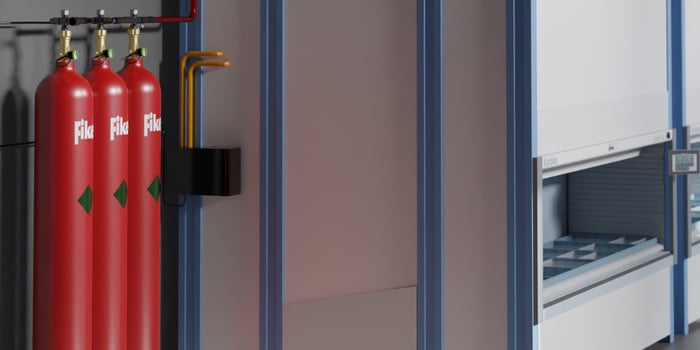Tool cribs make a direct impact on manufacturing operations, contributing to the speed, efficiency, and visibility of just about every process on the floor. As manufacturing processes grow more complex and production demands intensify, traditional manual cribs face mounting pressure (and spiraling shelf-space square footage), especially at high-mix, low-volume production facilities.
To respond, manufacturers are increasingly turning to fully automated tool crib solutions capable of solving for today’s production complexity while making it dramatically easier to track tool use, extend tool lifespan, and speed up tool retrieval, all within a physical footprint that’s smaller than manual cribs.
In this article, we explain the fundamentals of automated tool cribs, break down how they can unlock operational benefits capable of driving immediate ROI, and explore the key elements of an effective tool crib automation solution.

What is an Automated Tool Crib?
An automated tool crib is a technology-driven storage and management system designed to efficiently track, secure, and retrieve tools. Instead of relying on manual logging and open shelving, an automated crib combines vertical lift modules with integrated software to provide inventory control, secure access, and real-time usage data. Tools can be retrieved or returned through software-driven prompts, ensuring accuracy and a clear record of every transaction.
Automated vs Traditional Tool Cribs
Traditional tool cribs typically rely on manual bins, handwritten logs, and room-based access, processes that are time-consuming and prone to error as complexity grows. Missing items, duplicate tool pulls, and operational bottlenecks are all distinct risks, especially in high-mix manufacturing environments. For manual systems, scaling means adding more aisles (and more valuable square footage on the floor).
By contrast, an automated system centralizes storage, systematically enforces permissions, and streamlines tool retrieval.

Here’s how an automated tool crib works:
Storage
In a traditional tool crib, storage often takes the form of open shelving, bins, or caged areas with limited organization. This leaves valuable tools exposed to dust, misplacement, or accidental damage.
An automated crib, by contrast, leverages enclosed vertical lift modules with configurable trays, storing tools securely while preserving valuable floor space.
Inventory Tracking
Traditional systems depend on handwritten logs or scattered spreadsheets to track tool usage, which frequently leads to errors, gaps, and wasted time reconciling records.
Automated cribs eliminate this guesswork with a centralized digital database that updates in real time, logging every interaction the moment a tool is checked in or out.
Access Control
In a manual crib, access is generally tied to a room or cabinet key, making it difficult to know who used which tool and when.
Automated systems enforce accountability by requiring secure, permission-based logins. Every user action is tracked, providing full transparency and reducing the risk of loss or misuse.
Tool Retrieval
Locating tools in a traditional crib can be slow and inconsistent, with workers manually searching shelves or bins until they find what they need.
Automated systems streamline this process: software sends the request, pick-to-light guidance pinpoints the correct tray, and the tool is delivered to the operator within seconds.
Visibility and Reporting
With traditional cribs, reporting is limited and typically reactive, providing little real-time insight into tool lifecycle, usage trends, or cost allocation.
Automated cribs close this gap by offering detailed, real-time reporting.
.jpg?width=1000&height=667&name=Kardex_img_customer_USNR_12%20(1).jpg)
The Benefits of a Fully Automated Tool Crib
A comprehensive automated tool crib solution (like the Kardex Shuttle Vertical Lift Module (VLM) combined with ZOLLER Tool Management Software) can not only boost workflow efficiency but directly solve chronic shop floor challenges that drain time, money, and productivity.
Manufacturers can realize tangible ROI from day one of implementation across each of the factors explained below.
1. Gain End-to-End Tool Visibility
With an automated system, every transaction is logged and tracked in real time. Managers know what they have, who is using it, and when it was last in service. This prevents duplicated pulls and lost tools while creating a clear chain of custody that encourages accountability across the floor without slowing down productive work.
2. Maximize the Life of Your Tools
By recording the actual usage time of a tool rather than how long it sits in storage, tool management software enables more accurate lifecycle tracking. For expensive, high-value tools, this difference translates directly into substantial cost savings and extended tool life.
ZOLLER Tool Management Software extends this benefit by consolidating regrind tracking, lifecycle management, and compliance reporting into a single system. By centralizing these functions, operators simplify day-to-day oversight work, streamline regulatory record-keeping, and unlock substantial long-term savings.
3. Free Up Valuable Floor Space
Space on the manufacturing floor is a premium resource, and traditional cribs often consume more than their share. Automated systems reclaim this valuable real estate by storing tools vertically in enclosed towers.
For example, the Kardex Shuttle Vertical Lift Module (VLM) can reduce storage footprints by up to 85% compared to manual cribs, freeing space that can be repurposed for additional production capacity (or a safer, less cramped working environment).
.png?width=1200&height=628&name=USNR_ASRS_Automated_Manufacturing_ShuttleXP_03-1200x628-a0aa05d_FeaturedImage%20(2).png)
4. Speed Up Your Manufacturing Process
Automated retrieval eliminates wasted time spent searching shelves or waiting for manual approvals. Role- and process-specific job kits can be pulled instantly, with trays delivered in seconds instead of hours. This directly enables smoother workflows that reduce downtime and keep production moving.
5. Get Secure, Centralized Storage
An automated tool crib creates a controlled environment where high-value tools are protected from loss, damage, and contamination. By moving away from open shelving and unsecured cages, manufacturers can safeguard critical assets while ensuring they remain clean, organized, and ready for use. Access is limited to authorized personnel, reducing the risk of shrinkage and improving accountability.
For example, the Kardex Vertical Lift Module keeps tools shielded from dust and debris, while permission-based logins ensure only approved users can retrieve them.
6. Improve Ergonomics and Safety for Your Technicians
An automated tool crib should be designed to deliver tools at an ergonomic height, eliminating the repetitive bending, reaching, and lifting that can cause strain over time. For heavy or oversized parts, integration with lifting aids such as cranes or conveyors can further mitigate physical risks.
7. Simplify Your Year-End Inventory and Cost Center Accounting
Digital tracking within an automated crib ensures that every interaction is precisely recorded. This automatic record-keeping makes reconciliations straightforward and dramatically reduces the time needed for manual inventory checks. With software assigning usage to specific jobs, machines, or departments, cost center accounting is much faster and more accurate, giving managers clear visibility into spending patterns and resource allocation.

An Automated Tool Crib in Action
ZOLLER’s own 44,000 sq. ft. North American headquarters in Ann Arbor, Michigan, provides a vivid illustration of tool crib automation in action. At the center of the facility, an 8,800 sq. ft. Industry 4.0 Technology Center serves to showcase Zoller’s leading array of cutting tool handling solutions.
This facility relies on three Kardex Shuttle Vertical Lift Modules, each standing 26 feet tall, to manage thousands of specialty cutting tools and spare parts.
The Kardex Shuttles form a compact, centralized hub for tool storage, replacing multiple aisles of racking and shelving that would otherwise have been required. Pick-to-light technology directs operators to the exact item location, accelerating retrieval while boosting accuracy. Every transaction is time-stamped and tied to a user ID, allowing ZOLLER to track tool lifecycle based on actual usage rather than storage time.
This approach has proven especially valuable for high-cost cutting tools, where precise usage data extends tool life and supports reliable regrind management.
In addition to tool storage, the VLMs support spare parts fulfillment for customers across North America. Orders feed directly from ZOLLER’s ERP system into the Kardex Shuttles, which deliver the correct tray to workers for picking and shipping.
According to company management, “Managing our spare parts inventory with shelving would have required double the floor space. The Kardex Shuttles are also much more efficient; workers shouldn’t have to run around looking for parts in shelving.”
You can learn more about this tool storage automation success story here.

How to Build Your Automated Tool Crib Storage Solution
Fundamentally, automated tool cribs combine physical storage automation with digital tool management. The physical side ensures tools are stored securely, in less space, and delivered quickly to the operator. The digital side ensures every transaction is logged, every lifecycle is tracked, and every tool is tied to the right job or cost center.
Kardex Shuttle Vertical Lift Modules (VLMs) and ZOLLER Tool Management Software (TMS) provide a illustrative example of how these two elements should be tightly integrated for seamless use in day-to-day operations on a busy manufacturing floor.
Kardex Vertical Lift Modules (VLMs)
Kardex VLMs are enclosed, vertical storage towers designed to handle a wide range of tool sizes and weights. By consolidating storage into a vertical footprint, they can reduce floor space requirements by up to 85% compared to traditional shelving. Each module uses pick-to-light technology to guide operators to the exact tool location, improving speed and accuracy while minimizing errors.
ZOLLER Tool Management Software (TMS)
ZOLLER TMS serves as the digital backbone of the crib, maintaining a centralized database of every tool. The software tracks lifecycle data, usage history, cost center allocation, and machine assignments, giving managers a complete picture of tool availability and condition. It also integrates directly with CAM systems and job sheets, ensuring that tool data aligns seamlessly with production workflows.

How they Work Together to Close the Loop for Tool Storage
Together, the Kardex VLMs and ZOLLER TMS create a true closed-loop solution that connects storage directly with tool planning and usage. The TMS issues a job or tool request, the VLM delivers the correct tray to the operator at the right time, and every step is automatically logged. Once tools are used, they are checked back in, cleaned if required, and re-inventoried, closing the loop with a full digital record.
FAQ:
Q1: Do I need to replace my current tool management software?
Not necessarily. ZOLLER’s TMS can integrate with many CAM systems and job planning tools.
Q2: Can I store both small inserts and large dies in one system?
Yes. Kardex Shuttle trays are configurable with partitions, holders, and weight capacity up to 2,200+ lbs per tray.
Q3: What industries benefit most from this setup?
Automotive, aerospace, machining, medical device, precision tool manufacturing, and any high-mix/low-volume shop.
Q4: Is this system scalable as I grow?
Yes. The ZOLLER-Kardex combination is modular, add more VLMs or software licenses as your operations expand.

How Can You Take Advantage of Automated Tool Crib Storage?
The manufacturing floor leaves little room for wasted time, space, or resources. Automating your tool crib is one of the most direct ways to drive ROI, whether through extending the usable life of expensive tools, streamlining daily operations, or freeing up critical square footage for production.
With the right system in place, the crib transforms from a persistent bottleneck to a scalable source of efficiency, precision, and long-term cost savings.
>>> Check out the VLM in action
If you’re ready to see an automated tool crib up close, book a free site visit to see how an automated tool crib could be configured for your facility and receive a custom quote tailored to your requirements.

.png?width=893&height=500&name=USNR_ASRS_Automated_Manufacturing_ShuttleXP_03-1200x628-a0aa05d_FeaturedImage%20(2).png)


